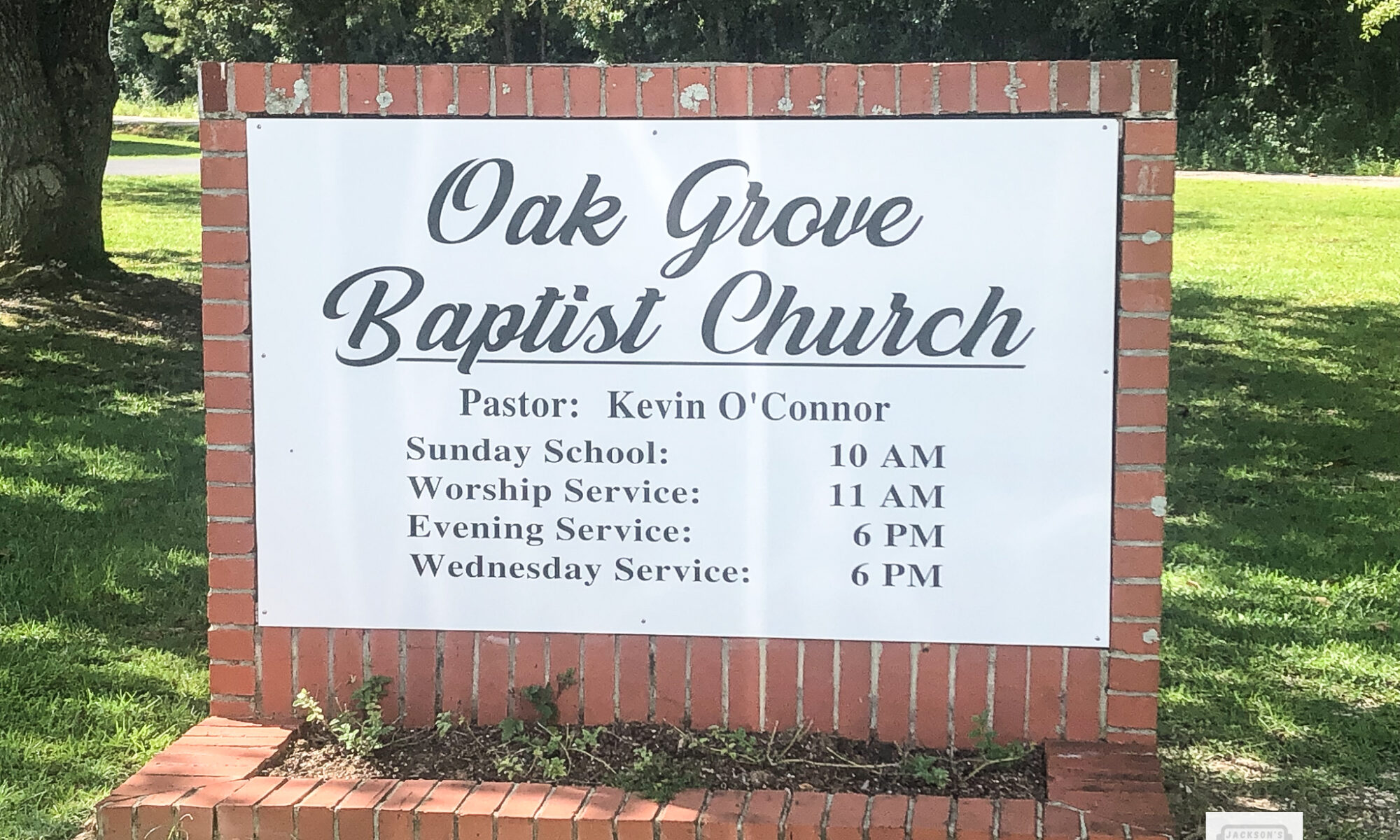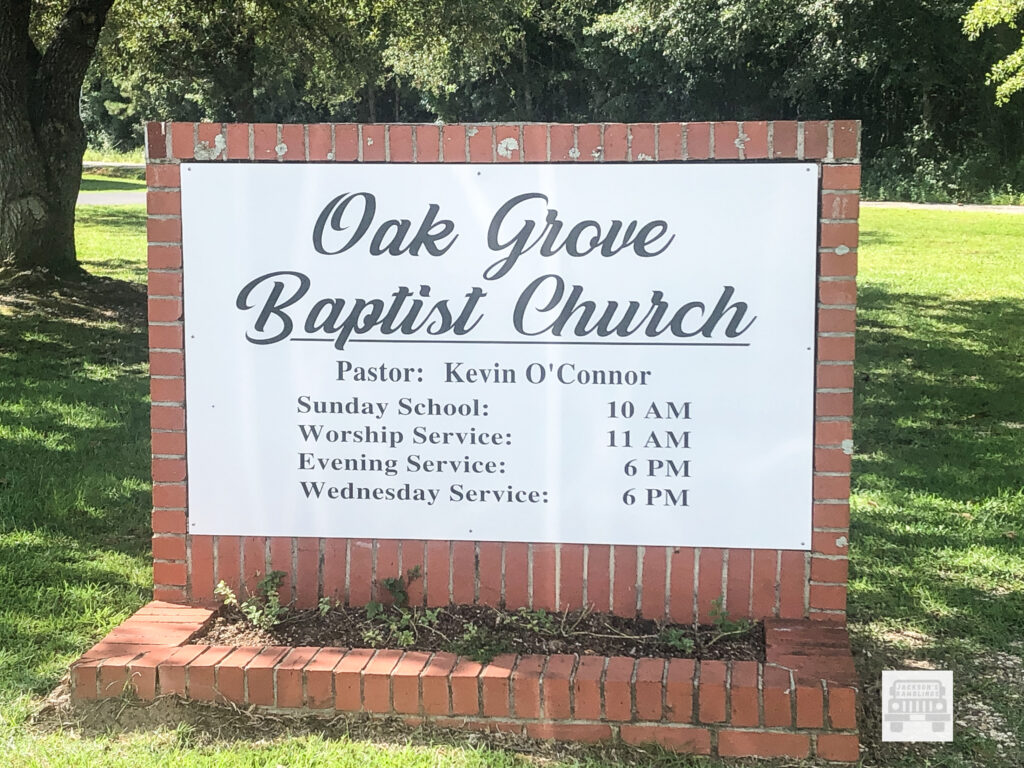
I have talked to several people who like myself are always digging for things associated with the history of our great land. One thing that I have heard over and over again stated is the phrase, ”I have passed that one a thousand times but never thought about the history of it.” It is like they are hiding in plain sight.
One of those things for me is the Oak Grove Baptist Church outside of Frisco City, Al. Possibly because the church we look at today for many is a more modern beautiful building so therefore it doesn’t cross your mind to ask questions as to the age of the church nor the history of how it got to that point.
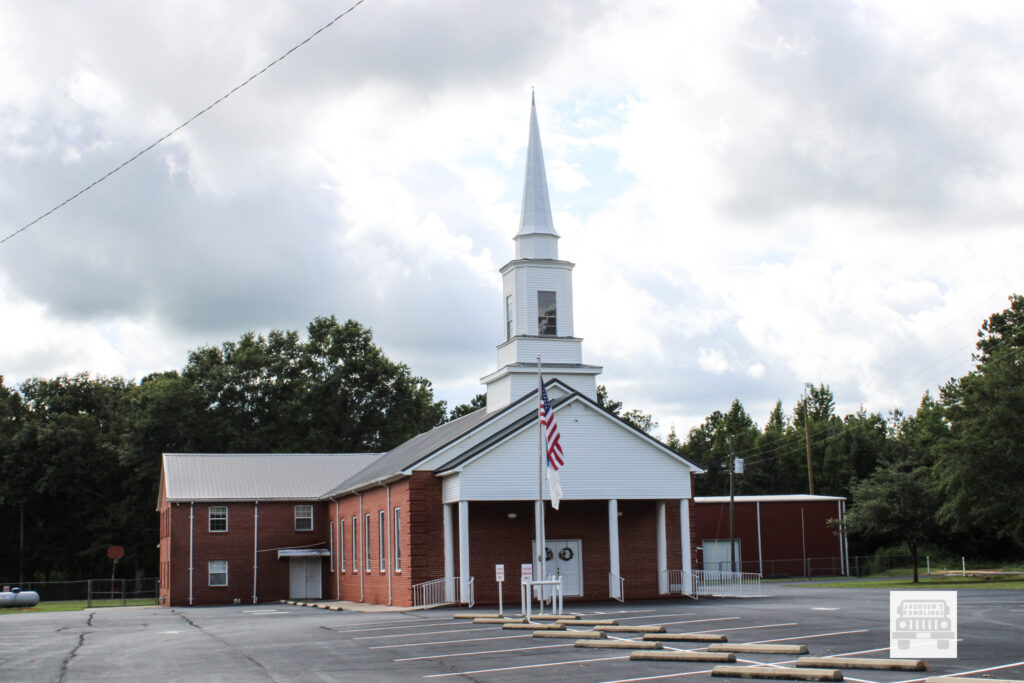
I was talking to my Brother-in-law one night and talking about churches and the age and history of some. He attends Oak Grove and he started telling me about it. He then stated I can get you the history of this one and he did. I was furnished this information by Mrs. Mary Ida Barnes. Once I started reading I was amazed.
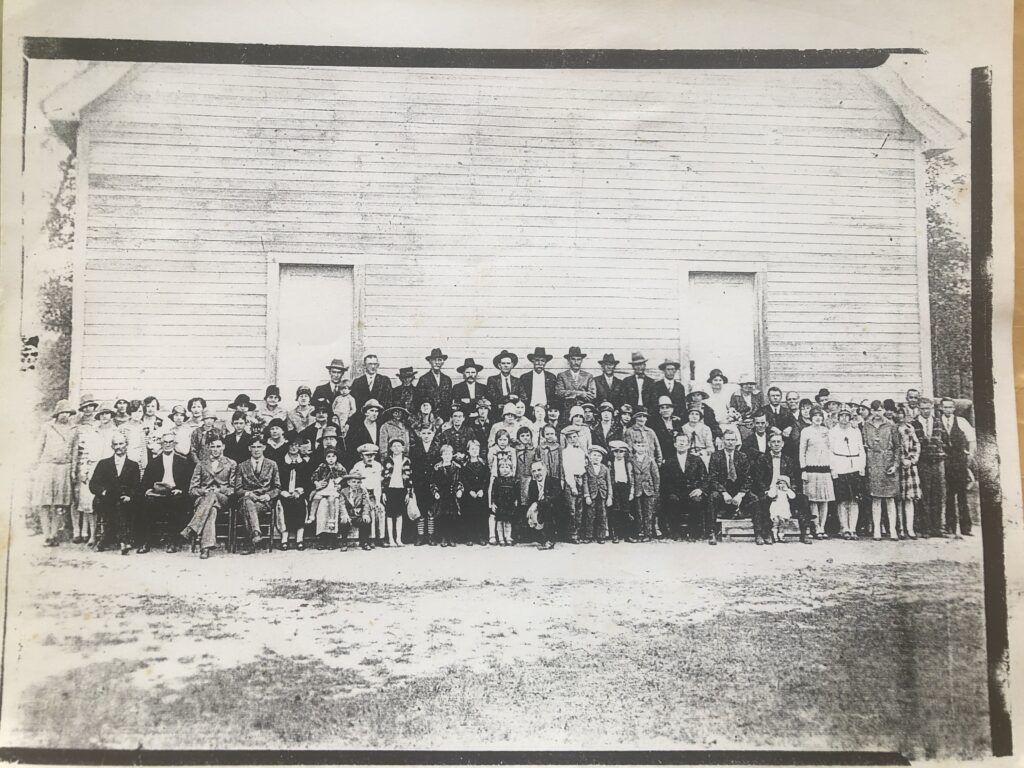
She sent me a copy of a history that was written by Mrs. Lewis Blanton to read and get information from. In this story I will quote excerpts of information from this writing.
All old pictures furnished by Mrs. Mary Ida Barnes.
All credit of this historical information I give to Mrs. Lewis Blanton.
The Beckbe Baptist Association had been organized in 1816 and included several south-western counties of Alabama, including Monroe County. This, the first and oldest association in Alabama was later renamed the Bethlehem Baptist Association and continues to be strong, active, and respected today.
As the Southwestern portion of Monroe County began to grow, a need arose for a missionary Baptist church.
A concerned group of Baptists decided to establish a church in the fast-developing community. John Wesley Broughton, a planter who had been a postmaster in Tekoa for several years, donated land for a missionary Baptist church a short distance from Tekoa. The original members of the newly named Oak Grove Baptist Church, so named because of the large, aged oak trees in the vicinity, met in a house on the site of the donated Broughton property. The first service was guided by Rev. J.L. Eddins and Rev. Sam Jones.
The church began to grow as the county began enjoying a semblance of prosperity after the War. As it grew, it fulfilled a great need for Tekoa and the surrounding areas of the county. Two years after the founding of the church, Monroe County suffered a severe winter, and new records were set as the ground was covered with six inches of snow. It would appear that the church had chosen a fairly prosperous time for its inception, for in 1888 for the first time in nearly a quarter of a century, Monroe County was finally out of debt.
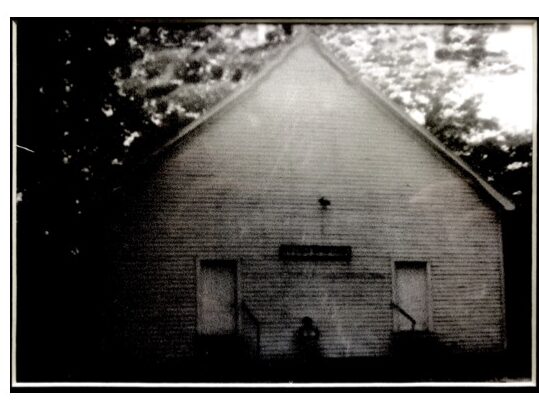
Not long after the church was established, a visitor came to the house. The man (legend has it that he was a colored man) wandered into the house and stayed there. This occurrence would have been a minor one except that this now infamous visitor was a victim of smallpox. The man died in the “house” as the disease claimed him, and in a desperate effort to curtail the spreading of the disease, the members of the church burned the building.
The congregation erected a new building on the site cross from the present-day parsonage. This second building would be used until 1908.
During the early years of the church, the new converts were baptized in a pool between the Blanton and Broughton places, behind the area of the first church building. Then the church began using a pool near the old Alec Norris place, which was towards Jones Mill. Soon afterward, the church began baptizing in a pool behind Mr. Bill Sawyer’s place. Here Oak Grove built pool houses which served as dressing rooms. The church maintained this area for baptisms until the pool was placed inside the sanctuary.
Oak Grove came to the assistance of Howard College in 1869 when he Alabama Baptist Convention was in much need of funds to relieve the debt of he college. The college had founded in 1841 as an institution for men and would later become the co-educational Samford University.
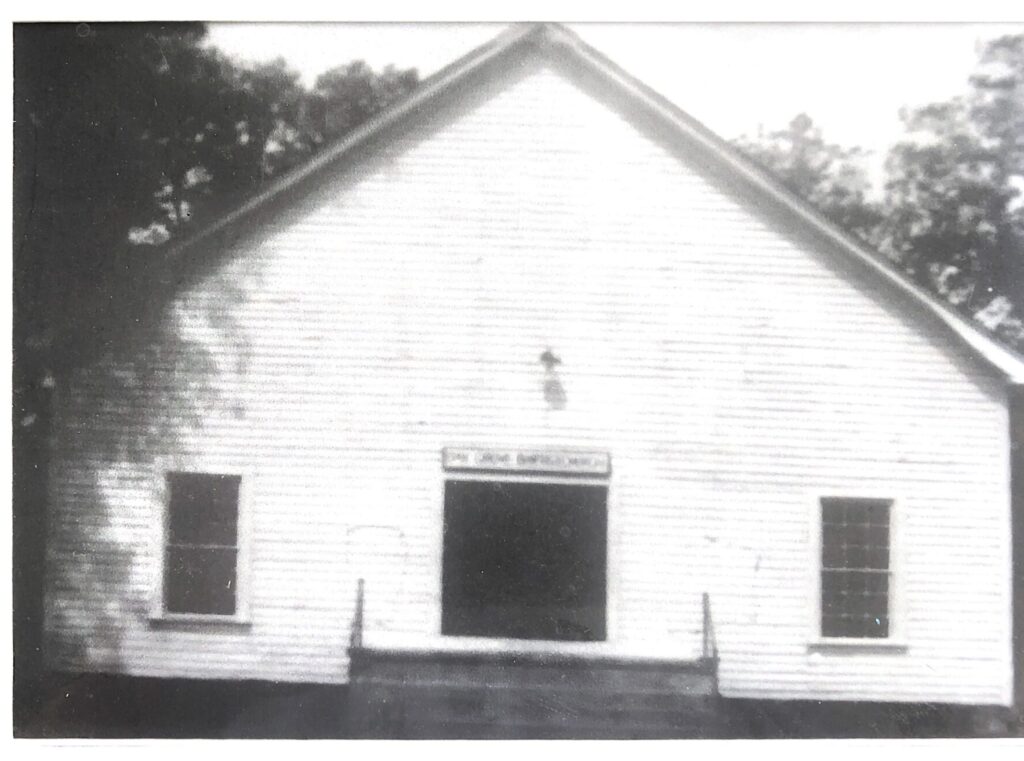
1897 was to be a particularly productive year or Oak Grove. The church sent its pastor J.W. Riffe, as a delegate to the Alabama Baptist Convention. 1897marked the first year of a Sunday School at Oak Grove (according to the Associational minutes). Under the leadership of Mr. Lorenzo Wiggins, the Sunday School Superintendent, the Sunday School that year was the second largest in the Association, second only to the First Baptist Church of Monroeville.
In an attempt to improve the church, a committee was designated on October 14, in order that the spiritual condition of the church might be examined. This committee was intended to insure that the church as growing in a spiritual sense. The members were obviously concerned with the spiritual needs of the church body.
Not until 1902 was Oak Grove to house the annual meeting of the Bethlehem Baptist Association. IN that year the Association was 86 years old, and the meeting was held in the second church building of Oak Grove. Both the third and fourth “houses” would host the Associational meetings on several occasions.
W.N. Huckabee of Pineville came to the church in 1903. This gentleman served as pastor for eighteen years, until 1921, excepting only a brief interval in 1909 when L.C. Dewitte served in that position.
The second church building began to fall in disrepair after the turn of the century. In 1908 the members decided that the church was not safe and that is must be substantially repaired or a new building should be erected. After a generous grant of land by Mr. W.M. Lane, the members decided to build a new “house”. On this site, the site of the present building, the new “house” was built. During the period of construction the church members met in the Tekoa schoolhouse. The new sanctuary was embellished by oil lamps with beautiful floral shades. Once the new church-affectionately in recent years referred to as the “old church” – was built, it quickly became an integral meeting place for the community. The building was designated as a voting area, md the church itself was used until the voting house was built. On July 19,1910 the church granted permission to the County Farmers Union to meet in the church building.
In 1911 the South was still suffering from the 1907 Panic. Monroe County was in need for as Christ promised, “the poor were still with us”. Oak Grove established a committee to see to the needs of the poor. After its inception, the committee valiantly and unendingly saw to the ever-pressing needs of the poor. The congregation labored unceasingly giving to those who were less fortunate.
With the coming of World War 1, the church, like the nation, knew the tragedy of war. The lives of many sons of the county were claimed as husbands, sons, fathers’ brothers and beaux risked their lives to protect their home and country. So many paid for this protection with their lives. Certainly the long war was ever present o the minds of the members of the church. Even though countians had purchased numerous war bonds, they could not and would not neglect the spiritual needs of the soldiers. On May 12, 1918 an offering was taken after services “for the purpose of helping preach the gospel among our soldier boys”. The church called W.N. Huckabee to serve as pastor on November 10, 1918 – only hours before the Armistice.
With peace declared God blessed America with a new prosperity. Oak Grove must also have been enjoying prosperity of the 1920’s for in 1924 a committee was appointed for the purpose of buying the pastor, Rev. W.A. Davis, an automobile. AS well, the organ which had been a part of the church for decades was sold and a new piano was purchased in 1927.
Two years after the purchase of the piano, the stock market on Wall Street crashed. This event at first may have had little effect on Monroe County but this occurrence developed into the Great Depression. The church, although hard pressed for funds, survived. The effort which had been extended toward the poor and needy continued even though many members of the congregation themselves suffered privation. Money became even more scarce, and the pastor was frequently paid in flour, chickens, and most especially in gallons and gallons of cane syrup. Tithes were also taken in this manner. Between 1931 and 1932 100 pounds of hay were collected as an offering.
The spirit which had sustained the church through hard times, wars and prosperous times was severely tried. But the brave and stout-hearted members refused to allow deprivation to defeat them. The aged proverb concerning “stepping out on faith” was proven true time and time again. With a never-failing faith in God and he determination of everyone to do his part- to do what had to be done- the church persisted. These fine efforts did not go unrewarded for in 1936, I the middle of the Great Depression, the church raised $171.62 selling ice cream at a nickel a serving. In addition, the church acquired electric lights which were operated by a generator long before the transmission lines were erected. Here was a strong evidence that the membership had faith several times the size of a mustard seed.
When the decade of the 1930’s passed, with it passed the marking of the 50th anniversary of the Oak Grove Baptist Church in 1933. The years had gently passed Oak Grove. The church provided a semblance of security as the grandchildren of charter members began to accept responsibility within the church. The flame had been tossed and blown, but nothing would snuff it out.
The peace which had brought balm to a troubled land was sharply destroyed that Sunday morning when the Japanese bombe Pearl Harbor. Once again the members of the church were to sacrifice for the war effort. Men of the church and relatives went to fight at faraway places such as the shores of Normandy and the isle of Iwo Jima.
Many of these men would never return. Some of these families would again see their men fight valiantly in Korea and Viet Nam- some of our heroes returning, others to be only memories in the coming years. In all of these conflicts the support of the church was constant Daily prayers ascended to heaven.
Once more Oak Grove was to rind itself in peace time and mew matters of concern were pressing. The members recognized the need for a parsonage. In 1954 Mr. Fred Broughton, grandson of John Wesley Broughton, generously gave the church and acre of land for a new pastorium. The site was to be practically the same site as that of the first church building. It was completed and paid for in le than a year. The years 1954-1955 marked some of the greatest progress in the church’s history. There were 86 additions to the church, 46 by baptism. The Sunday School enrollment climbed from 78 to 189 and the Training Union enrollment climbed from 51 to 136.This growth was accomplished under the leadership of Rev. W.Q. Howe. Oak Grove rendered assistance to the Indian Mission in 1957, a time when many had forgotten the struggling Indians of Alabama.
In the summer of 1958, the church after a considerable effort which included the buying of bonds had a new sanctuary. The sanctuary had been built after the completion of he educational building. A dedication ceremony complete with the laying of a cornerstone, marked the event. The gleaming white walls were replaced by a new look of solid, stately red brick, crowned with an inspiring steeple which lifts eyes upwards toward heaven. The “old church” was gone, but the new building with its modern appearance promised a new, progressive era. It conveyed to the county a message- the message that although Oak Grove Baptist Church displays a reverence for its cherished heritage, its chief concern lay in serving the Lord today and in the future. The “new church” made a statement that the church would not remain stagnant while the country changed, but would meet the needs of a fast changing society.
For over 120 years the members of the church has displayed a constant devotion to our Lord, our Southern Baptist beliefs and our county. No adversity—not war, depression or apathy—has snuffed the flame which burned so brightly in 1883. May Oak Grove’s light always shine brightly for the Lord.
One only knows of the greatness of our historical churches today if he or she is willing to research what great things they have done or what hard times and sufferings that they have endured and still came through to endure.
